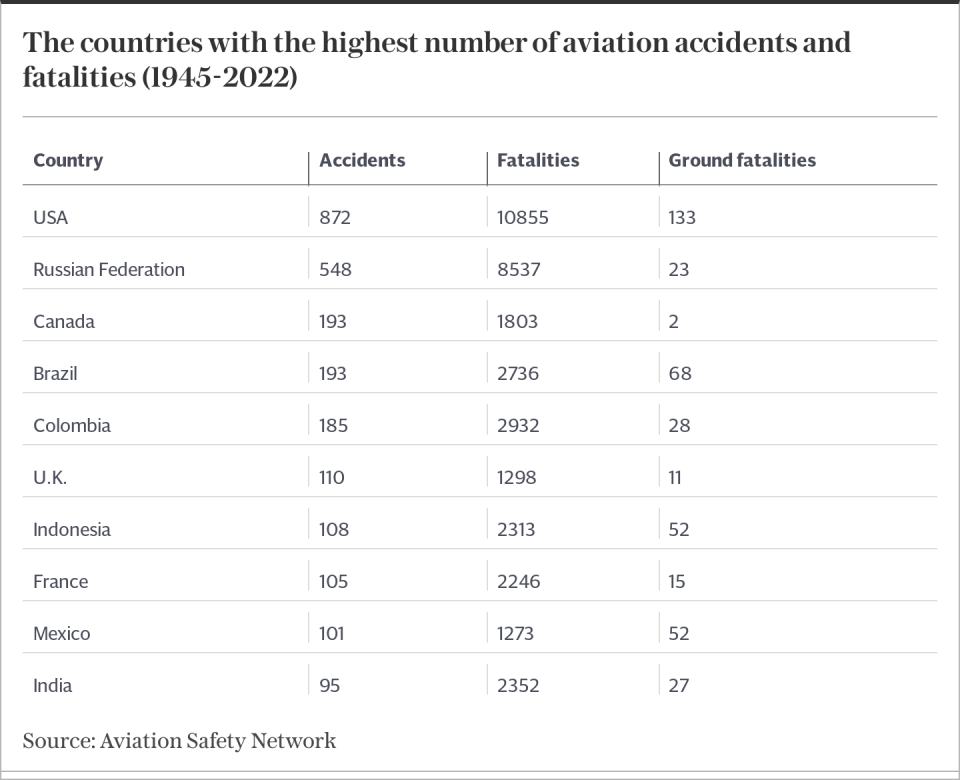The most dangerous countries on Earth in which to fly

Nepal: home to the world’s tallest mountains, remarkable ancient sites and lush rainforests. Despite this geographical prosperity, the country also holds another, less fortunate, title: one of the world’s most unsafe countries in which to fly.
According to the UK Air Safety List, a roll-call of airlines that are banned from British airspace for being actively hazardous, some 21 Nepalese operators are forbidden to fly from and to the UK.
The list is an index of the most perilous operators in the skies. Airlines are added to the roster by the Department for Transport if they do not fulfil the “necessary international safety standards”, based on advice from the Civil Aviation Authority and the UK Flight Safety Committee. Often, this is in the aftermath of a terrible accident or, at best, an erratic near-miss.
This does not prevent holidaymakers from getting to the countries themselves. There are plenty of other operators making the trip from the UK to most of these nations, which include places such as Angola, Suriname and Venezuela.

But internal flights, especially in countries such as Nepal, are often unavoidable. The mountainous terrain, poor road conditions and crowded public transport system mean that exploring the country regularly necessitates using domestic airlines. But this increasingly seems like a dangerous option.
In January, a plane operated by Nepalese airline Yeti Air crashed in Pokhara, a city popular with tourists trekking in the Himalayas. All 72 passengers on board were killed, making it the 11th fatal air accident in the country in as many years.
The official cause of the crash has not yet been determined, but initial inquiries have found evidence of a loss of power, in combination with a possible pilot error. It is not particularly reassuring for tourists looking to travel to the country’s most beguiling mountain range.
Although there is no definitive global reference of aviation safety by country, by most metrics Nepal is one of the world’s most dangerous places to fly. The website AirlineRatings.com, which ranks airlines based on safety, refuses to even evaluate Yeti Air, and its subsidiary Tara Air, because of its poor crash record.

Which airlines are banned?
There are 25 nations that have airlines on the list. Some, such as Russia’s Atran and North Korea’s Air Koryo, are very unlikely to concern tourists. Others, such as Nigeria’s Med-View Airline, once flew between London and Lagos (and now finds itself suspended).
Avia Traffic Company, which operates out of Kyrgyzstan, is banned in European airspace but regularly travels between the former Soviet state to Turkey, India and Egypt. In 2015, eight passengers were injured, and the left engine was ripped off, during a hard landing at Osh Airport in the south of the country. Four more Kyrgyz airlines are also listed on the Air Safety List.

Some airlines are unnerving enough in name: airlines on the list include Busy Bee in the Democratic Republic of the Congo and Air Company Air in Kyrgyzstan, which don’t exactly fill one with confidence.
But the list isn’t entirely concerned with smaller operators. Pakistan International Airlines, the country’s flag carrier, has been prevented from entering UK airspace since July 2020, shortly after it was revealed that around a quarter of pilot licences issued in the country were not genuine. The airline subsequently grounded 150 of its 434 pilots, ultimately suspending seven for having counterfeit credentials.
Good grace towards the airline was, perhaps, running rather thin, as two months prior to this, a flight travelling to Lahore crashed at Karachi’s Jinnah Airport, killing 97 passengers and injuring a further two. The cause of the crash remains unknown.

What does it mean for travellers?
Remarkably, flying with these airlines is not likely to affect insurance premiums. A spokesman from the Association of British Insurers said that “travel insurers would not check an air carrier’s safety record”, meaning the risk is, essentially, held entirely by the passenger.
Policies are based on a range of factors, including “destination, age of traveller, any pre-existing medical conditions,” but not the inclusion on the Air Safety List. However, if an airline is added to the list after a passenger has booked a flight and it then gets cancelled, Air Passenger Rights Regulations mean that there is a right to both reimbursement, rerouting and possibly compensation.
While it is difficult to ascertain exactly how dangerous an airline is – this will often depend on the flyer’s appetite for risk –there is a certification scheme for operators. The IATA Operational Safety Audit (IOSA) is an evaluation system that assesses whether or not an airline adheres to stringent safety regulations, and is reviewed every two years. It is a good guide to the sorts of airlines one might want to avoid: none in Nepal have the certification.
That isn’t to say that every airline on the UK Air Safety List lacks the IOSA, though. Kam Air, an Afghanistan-based operator, technically has the certification despite a fatal crash in 2005 and a tail strike in 2010.

For those who do have to fly, the Foreign, Commonwealth and Development Office recommends checking weather conditions and changing plans accordingly.
For Geoffrey Thomas, the editor-in-chief at AirlineRatings.com, it is important to assess the risk on a case-by-case basis. He said: “Flying gets safer every year. But there are danger areas, where the standard of training is a big issue. For somewhere like Nepal, the nature of the terrain and airports makes the situation very difficult to improve.”
Ultimately, some tourists will continue to use the banned operators. The Air Safety List might prevent a passenger from flying home on a certain airline, but within a country, it’s up to them. For Thomas, the choice is clear.
“Passengers need to be aware that flying around huge mountains onto tiny airfields carry significant risks,” he said. “Lukla Airport [in Nepal] is not Heathrow.”


